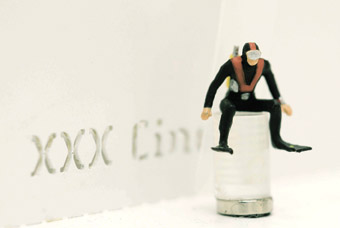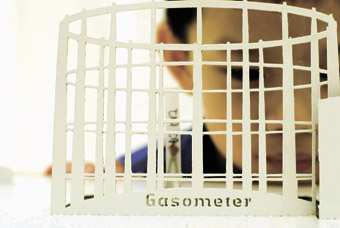from anywhere at any time
gabriella giannachi at play with blast theory

Day Of The Figurines 2006, Blast Theory
courtesy of National Museum of Singapore
Day Of The Figurines 2006, Blast Theory
BLAST THEORY’S LATEST WORK, DAY OF THE FIGURINES, WHICH RECENTLY RECEIVED AN HONORARY MENTION AT PRIX ARS ELECTRONICA 2007, IS A MASSIVELY MULTIPLAYER BOARD GAME FOR UP TO 1000 PARTICIPANTS WHOM PLAYERS CAN INTERACT WITH REMOTELY VIA SMS MESSAGES THROUGH THEIR MOBILE PHONES FROM ANYWHERE IN THE WORLD.
Day of the Figurines opened in Berlin in 2006, and has since been presented in Singapore, Brighton and Birmingham. It was developed by Blast Theory in collaboration with Nottingham University’s Mixed Reality Lab as part of IPerG, an EU funded research project investigating pervasive games and comprising a number of European research centres and universities including Fraunhofer Institute and Sony NetServices. For IPerG, pervasive games “are no longer confined to the virtual domain of the computer, but integrate the physical and social aspects of the real world” by extending conventional computer games in one or more of three dimensions.
Blast Theory’s Can You See Me Now? (2003-5), winner of the Golden Nica (2003) at the Ars Electronica Festival in Linz, explored spatial expansion by utilising the Global Positioning System (GPS) to track performers’ movements through a city which were then mapped onto avatars’ movements to allow for a chase between the performers in the city and the online players. Other Blast Theory works, such as Uncle Roy All Around You (2003), investigated social expansion by exploring the boundaries between the fictional world of a game and the physical reality of a city, implicating bystanders on city streets in the narrative of the game. In contrast, Day of the Figurines explores the theme of temporal expansion, unfolding slowly, over 24 days, through the exchange of just a few text messages each day.

Day Of The Figurines 2006, Blast Theory
courtesy of National Museum of Singapore
Day Of The Figurines 2006, Blast Theory
To participate in the game, players visit a physical space, which could be a museum, gallery, theatre or art centre, where they find a large-scale white metal model of an imaginary town at table height. Designed to act as a spectator interface, the board displays 50 cut-up destinations, based on a typical British town including, for instance, a 24 Hour Garage, Big Chef, the Blue Cross, a Boarded-up Shop, an Underpass, but also, ominously, the Nuclear Bunker and the Rat Research Institute. Two video projectors beneath the surface of the board shine through holes in the table reflecting off mirrors mounted horizontally above, thus enabling the surface of the table to be augmented with projections of information from the game. This augmentation system is turned on periodically to show the game operators where to move each figurine as they update the physical game board. For each figurine in turn, the augmentation system projects a line from the figurine’s current position on the board to its new position.
Players select a figurine from a display of 100 neatly arranged on a second table. The figurines are the size of a thumbprint, made of plastic, brightly coloured, and act as in a cartoon, allowing for, in Blast Theory founding member Matt Adams’s words, “a deeper level of identification than a more realistic portrayal.” Assisted by an operator, players give their figurine a name, an identity, and then watch as it is placed on the edge of town. Before leaving the space, they are given some basic instructions about the game, which explain how to move, speak, pick up and use objects, find other players, receive help or even leave the game.
From the moment of registration, the game contacts players through SMS messages. If players choose a destination, the figurines are moved towards it. Once the new destination is reached, they may encounter other players with whom they can exchange messages. Players may also encounter objects, such as ladders, billiard cues, photo IDs, wrist bands, fleeces, tea, saveloys, gas canisters, bodies and defibrillators, and be presented with missions and dilemmas in the form of multiple-choice and open questions, some formulated in real time by the game operators. Unlike in conventional games, players, who soon realize that they are refugees in this estranged town, do not really win or lose but rather learn how to survive by looking after their health, building on their game knowledge, responding to missions and dilemmas and helping other players. While time goes by, shops open and close, an eclipse takes place, a fete raises some money, an army occupies the town, light fades and dusk sets in, it becomes cold. Players, some chatty, some quiet, some active, some tentative, come and go, and, for nearly a month, become our companions, sharing information, circulating rumours, having enlightened or exhilarating conversations, some trying to help, some trying to hurt or even kill us, episodically and yet pervasively, in this curiously entertaining and yet also disturbingly estranging world.
being in the game
Here we learn that this game has no real winners, no final objective, but rather operates at the level of Heideggerrian dasein—being in the world. The spatio-temporal structure of the game is very complex and whereas players, subsequent to the encounter with the board, are under the impression that they inhabit a Cartesian world, the game in fact operates by a hub structure whereby all destinations are equidistant from one another. This creates a distorted spatial awareness, which affects the sensation that the game operates in its own space-time, not so much separately from as additionally to our day-to-day lives. Day of the Figurines is a sophisticated hybrid, encouraging, as IPerG member Markus Montola would put it, “minimal” roleplay and thereby allowing players to dip in and out of the game world from within the varied contexts of their own lives. The game narrative is carefully constructed to give the sense of an authorial presence but also to facilitate interactivity, as well as theatricality and performativity. Whereas the former allows for the creation of virtual spectatorship and audience, the latter is visible in the formation of more or less spontaneous performance events, such as virtual happenings, flaneurism and, perhaps even most innovatively, spatial and social co-presence which allows for a prolonged and efficacious form of social connectivity derived purely via the temporal augmentation of our lives.
I have now played Day of the Figurines three times (Berlin, Brighton and Birmingham) and have found the game just as absorbing and engaging as any faster, more immersive game. I have also found it structurally and aesthetically exceptionally rich, so much so that as yet I have not been able to explore all destinations and engage with all objects, dilemmas and missions. Although the game is unmistakably original, it contains a wealth of dramaturgical intertextual references that locate it between and beyond postmodernist practices spanning from Samuel Beckett’s Waiting for Godot and Endgame to Peter Eisenman’s Holocaust Memorial in Berlin and Peter Handke’s Kaspar Hauser, not to mention the world of pervasive and massively multiplayer games, as well as Blast Theory’s own mixed reality performance work.
Day of the Figurines is an exciting, complex, and decidedly original development in the work of Blast Theory that represents a milestone for disciplines as varied as Performance Studies and Computer Science, Visual Art and Psychology, Sociology and Game Studies. Not only is it the first game working entirely through SMS messages (linguists might of course see this as the first performative mobile phone game, based exclusively on speech acts. Philosophers might read it as a post-Wittgensteinian interpretation of language games), but it’s also the first original artwork to operate pervasively, episodically, and performatively that can be played from anywhere and at any time.
****
Julianne Pierce (ex-VNS Matrix, ex-Executive Director ANAT, Visual Arts Coordinator Adelaide Festival of the Arts, and Board Member Open City, publisher of RealTime), has been appointed Executive Producer to Blast Theory and leaves to join the company in the UK this September.
Blast Theory, Day Of The Figurines, various cities
www.dayofthefigurines.co.uk
www.blasttheory.co.uk
Mixed Reality Lab www.mrl.nott.ac.uk
IPerG www.pervasive-gaming.org
RealTime issue #80 Aug-Sept 2007 pg. 6






